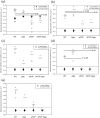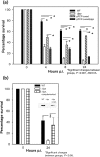Deletion of Braun lipoprotein gene (lpp) and curing of plasmid pPCP1 dramatically alter the virulence of Yersinia pestis CO92 in a mouse model of pneumonic plague
- PMID: 19589835
- PMCID: PMC2889417
- DOI: 10.1099/mic.0.029124-0
Deletion of Braun lipoprotein gene (lpp) and curing of plasmid pPCP1 dramatically alter the virulence of Yersinia pestis CO92 in a mouse model of pneumonic plague
Abstract
Deletion of the murein (Braun) lipoprotein gene, lpp, attenuates the Yersinia pestis CO92 strain in mouse models of bubonic and pneumonic plague. In this report, we characterized the virulence of strains from which the plasminogen activating protease (pla)-encoding pPCP1 plasmid was cured from either the wild-type (WT) or the Deltalpp mutant strain of Y. pestis CO92 in the mouse model of pneumonic infection. We noted a significantly increased survival rate in mice infected with the Y. pestis pPCP(-)/Deltalpp mutant strain up to a dose of 5000 LD(50). Additionally, mice challenged with the pPCP(-)/Deltalpp strain had substantially less tissue injury and a strong decrease in the levels of most cytokines and chemokines in tissue homogenates and sera when compared with the WT-infected group. Importantly, the Y. pestis pPCP(-)/Deltalpp mutant strain was detectable in high numbers in the livers and spleens of some of the infected mice. In the lungs of pPCP(-)/Deltalpp mutant-challenged animals, however, bacterial numbers dropped at 48 h after infection when compared with tissue homogenates from 1 h post-infection. Similarly, we noted that this mutant was unable to survive within murine macrophages in an in vitro assay, whereas survivability of the pPCP(-) mutant within the macrophage environment was similar to that of the WT. Taken together, our data indicated that a significant and possibly synergistic attenuation in bacterial virulence occurred in a mouse model of pneumonic plague when both the lpp gene and the virulence plasmid pPCP1 encoding the pla gene were deleted from Y. pestis.
Figures




References
-
- Agar, S. L., Sha, J., Foltz, S. M., Erova, T. E., Walberg, K. G., Baze, W. B., Suarez, G., Peterson, J. W. & Chopra, A. K. (2008a). Characterization of the rat pneumonic plague model: infection kinetics following aerosolization of Yersinia pestis CO92. Microbes Infect 11, 205–214. - PubMed
-
- Agar, S. L., Sha, J., Foltz, S. M., Erova, T. E., Walberg, K. G., Parham, T. E., Baze, W. B., Suarez, G., Peterson, J. W. & Chopra, A. K. (2008b). Characterization of a mouse model of plague after aerosolization of Yersinia pestis CO92. Microbiology 154, 1939–1948. - PubMed
-
- Anisimov, A. P., Bakhteeva, I. V., Panfertsev, E. A., Svetoch, T. E., Kravchenko, T. B., Platonov, M. E., Titareva, G. M., Kombarova, T. I., Ivanov, S. A. & other authors (2009). The subcutaneous inoculation of pH 6 antigen mutants of Yersinia pestis does not affect virulence and immune response in mice. J Med Microbiol 58, 26–36. - PubMed
-
- Brice, G. T., Graber, N. L., Hoffman, S. L. & Doolan, D. L. (2001). Expression of the chemokine MIG is a sensitive and predictive marker for antigen-specific, genetically restricted IFN-γ production and IFN-γ-secreting cells. J Immunol Methods 257, 55–69. - PubMed
Publication types
MeSH terms
Substances
Grants and funding
LinkOut - more resources
Full Text Sources
Other Literature Sources
Medical
Molecular Biology Databases
Research Materials

